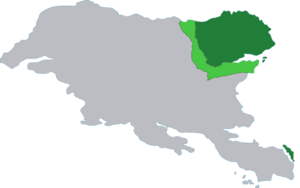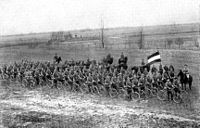Alscian Border War
| Alscian Border War | |||||||
|---|---|---|---|---|---|---|---|
| Part of Xevden's disintegration and Liberation War | |||||||
 Alscia (dark green) and TACS (light green) overlaid on a map of modern Gylias | |||||||
| |||||||
| Belligerents | |||||||
|
| |||||||
The Alscian Border War (Italian: Guerra di Confine Alsciana) was a conflict fought between Alscia and Xevden, beginning some time in the 1910s and lasting until Alscia's dissolution.
Hostilities involved Alscia's Border Guard engaging in incursions and skirmishes across the border to harass Xevdenite forces, and intervening in support of local Gylian insurgencies. The conflict was part of the Donatella Rossetti government's policy of keeping up pressure on Xevden. As part of Alscia's constructive ambiguity regarding its status, the conflict was officially portrayed as "self-defense" by Alscia against Xevdenite aggression, and legal tactics were used to ensure the Cacertian Empire was not drawn into the fighting.
Alscia's use of attrition warfare and aid of Gylian guerrillas resulted in an unofficial expansion of its territory. The territories it annexed were organised as Territori sotto amministrazione civile speciale ("Territories under special civil administration"). These were not included in Alscia's official statistics, and instead received their own oversight.
The border war was subsumed into the larger Liberation War in 1939, when Alscia voted to join the Free Territories.
Background
The Cacertian Empire's victory in the Cacerta-Xevden War resulted in the annexation of several territories, which became Alscia. The freedoms enjoyed by Gylians under Cacertian protection compared to the continued struggle against Xevdenite oppression defined Alscian identity, and bred some frustration that the Empire had ended the war with Xevden so quickly rather than press on towards total victory.
As a result, the Donatella Rossetti government adopted a policy of "maximum pressure" towards Xevden. It became a haven for Gylian radicals and a steadfast supporter of the Gylian opposition, using its autonomy to aid Gylians and advocate for international ostracism of Xevden. However, due to the fact of Cacertian suzerainty, the policy had to be executed in such a way as to prevent the outbreak of a war that would involve the greater Empire. Alscia thus maintained a Border Guard — in fact a full-fledged military force — and engaged in border raids and skirmishes to further grind down Xevdenite forces.
Conflict
The Border Guard used attrition warfare and guerrilla warfare tactics across the border. Its objective was to protect Alscia's borders and inflict continuous losses on the Xevdenites, without provoking an "official" war. It would isolate Xevdenite units and ambush them, stage feint attacks and retreats to disrupt their concentration, and target their supply lines. It encouraged Gylians to mutiny and desert from the Xevdenite army, and assisted Gylians who crossed the border into Alscia by firing at Xevdenite forces to tie them down.
The primarily defensive posture was out of necessity, as Alscia rigorously maintained throughout the war the narrative that it was defending itself against Xevdenite aggression and "provocations".
Beyond the border, the Border Guard was to assist the Gylian opposition however they could: linking up with rebels, smuggling radical literature, providing supplies, any measure that would encourage the Gylian resistance and demoralise the Xevdenites. The SRA's radio transmitters, built next to the border and broadcasting to Gylians in Xevden, were symbolically important, and thus the main target of Xevdenite attack plans.
Alscian strategy was shaped by geography. Its main focus was on the land border with Xevden. Iárus island was used as a naval base to harass Xevdenite shipping and blockade the coast, but logistics prevented sustained attacks towards Nerveiík. Military action was thus mainly aimed west and south.
As the conflict progressed, Alscian tactics became increasingly aggressive. The Border Guard encouraged rebellions and uprisings near the border, allowing it to then intervene on the side of the Gylian rebels. This approach allowed it to slowly expand territory. The heavily forested Nezyál, to the south, proved especially suited for ambushes and guerrilla warfare.
Due to the slow pace of advance and vagaries of geography, Alscia captured only two major cities in the Border War: Kyman and Nazrin. However, by 1939, it had achieved significant territorial gains: it had now moved its western border to the Enri river and Kackar mountains.
TACS
The territories that came under Alscian control were organised as Territori sotto amministrazione civile speciale ("Territories under special civil administration"), commonly known by the abbreviation TACS.
In practice, the TACS were governed as part of Alscia, but they were excluded from official statistics to maintain the legal fiction of the Border War, and instead had separate statistics and oversight.
Since most of the TACS were rural and sparsely populated, the Alscian government opted to simply implement direct democracy rather than establish comuni. Only Kyman and Nazrin had local government similar to other Alscian cities. Due to the special regime, anarchists became a significant presence in TACS' public life.
Economically, TACS benefited from Alscian land reform and public works, but could contribute little to the Alscian economy due to their ambiguous status. The government and SSA similarly used front companies, shell companies, and secret funds to conceal their involvement in the TACS. Overall, they were net beneficiaries, receiving more in spending than their tax revenues, and had the same standard of living as the rest of Alscia.
The unique status of TACS made them significant for the radicalisation of Alscia. During the 1939 sovereignty referendum, the TACS' separately-organised vote provided overwhelming support for joining the Free Territories.
Significance
The tactics used by Alscia — harassment of the enemy, fomenting rebellions to intervene, slow advance and consolidation — were taken up entirely by the People's Army and Free Territories during the Liberation War. They contributed both to the success of the People's Army and the length of the Liberation War, due to the discrepancy between the size of the territory and overall population numbers.
The war has sometimes been portrayed in Gylian pop culture as an absurd conflict, marked by slow advances, long periods of inactivity, and increasingly ridiculous veneers of legality, such as in the Brigitte Nyman comedy Babette s'en va-t-en guerre (1959) and the video game Rubis Cœur: Sky Captain (1992).
